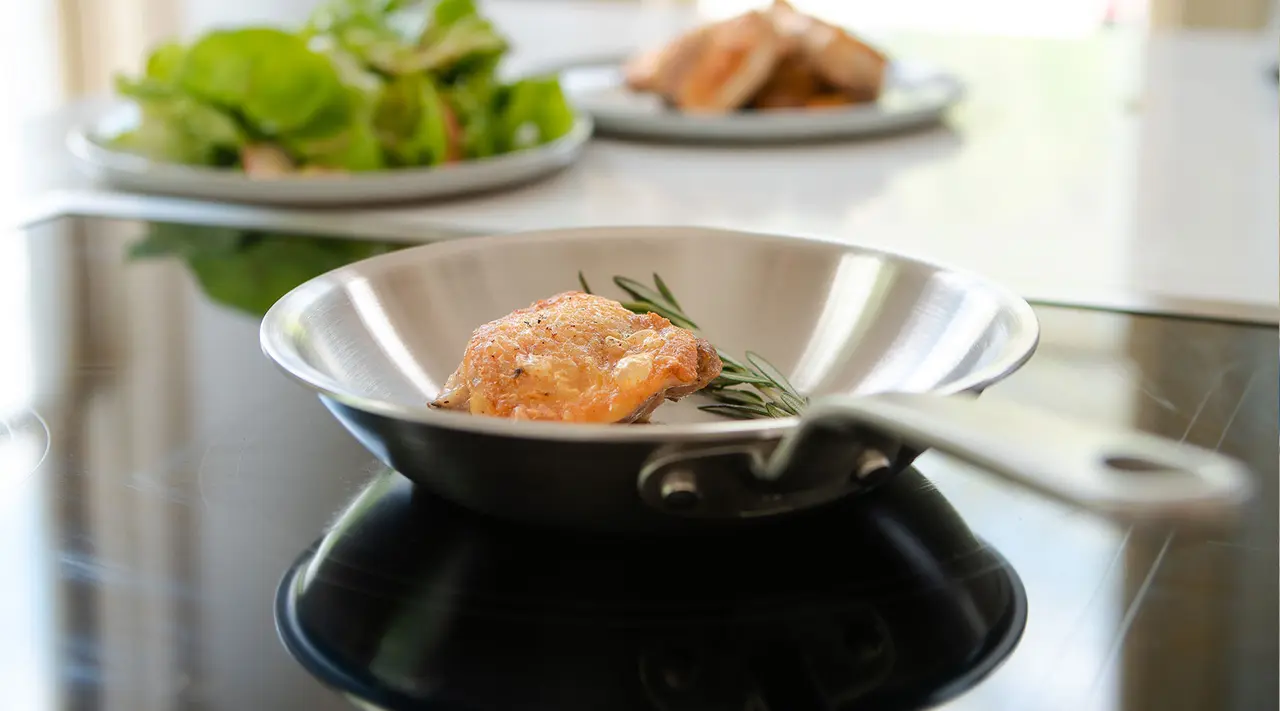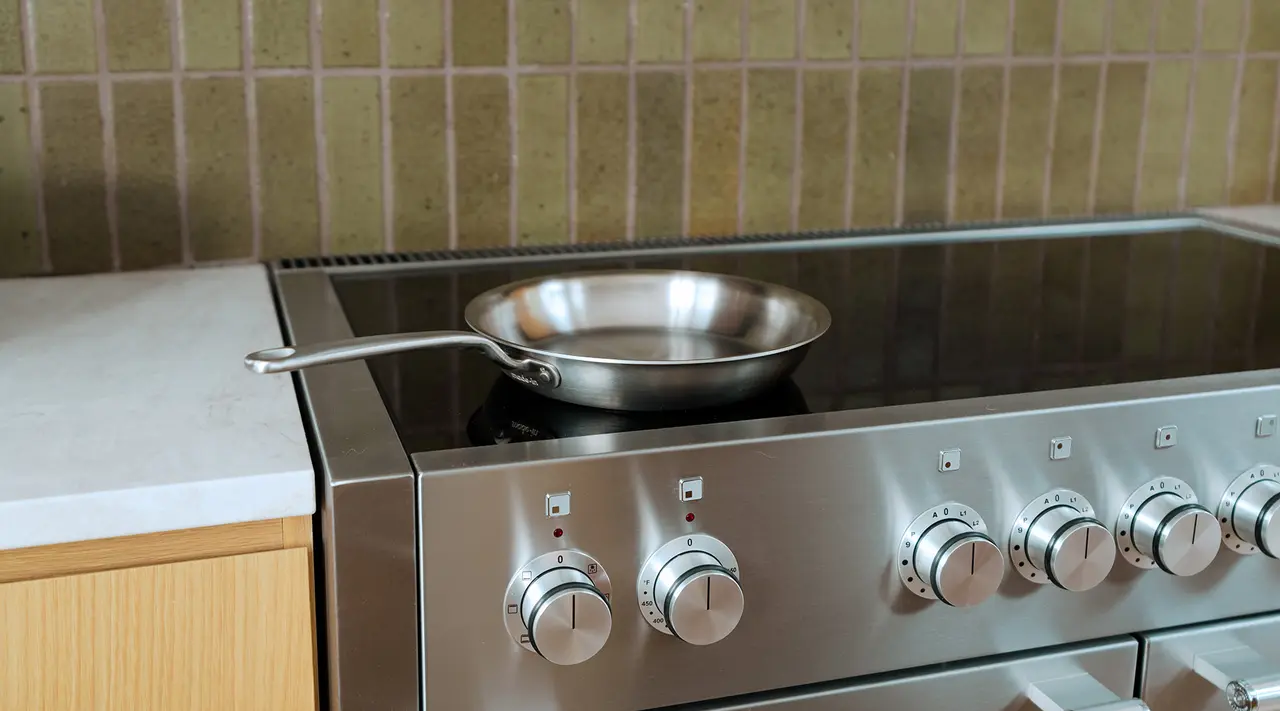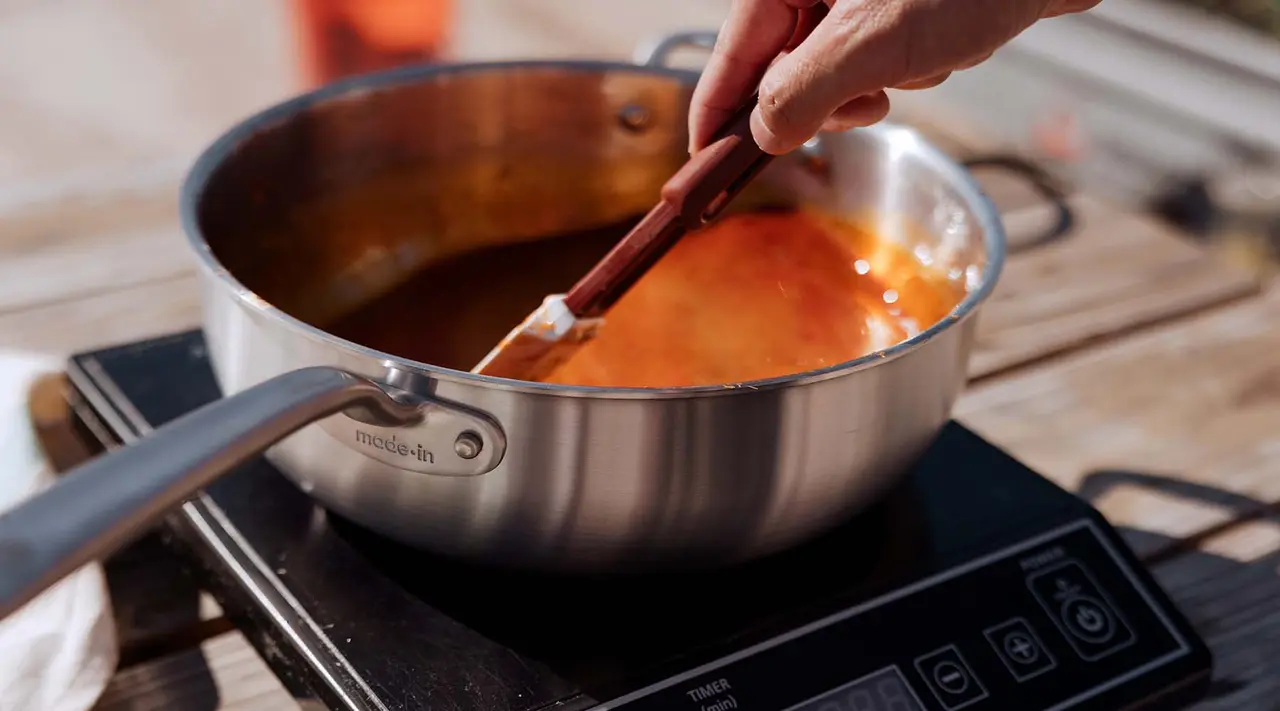Induction technology is nothing new: in fact, the first induction cooktop actually made its public debut over 90 years ago, at the 1933 Chicago World’s Fair. Yet despite having been around for nearly a century, this magnet-based cookware technology has seen a major uptick in popularity in recent years—in part due to growing public awareness of induction’s many health and environmental benefits, but also because it’s much more efficient and responsive than your typical gas or electric stove.
While most cookware is technically induction-friendly, some pots and pans just work a little better on these glass- or ceramic-topped stoves. Here’s how to maximize the fast-heating, energy-efficient benefits of induction stoves by choosing the right cookware.
Understanding Induction Cooking

Before we get into compatible cookware, here’s why—and how—induction actually works as a cooking method.
What Is Induction Cooking?
Induction cooktops generate heat using magnets: basically, you place a compatible—i.e. ferromagnetic—pot or pan on the surface of the stove, turn it on, and the cookware heats up. There’s little to no transfer of heat to the surrounding air, or to the cooktop itself. With no wasted energy, induction cooking is faster and more efficient than conventional stoves, which work by conducting heat and transferring it to the pot or pan via electric coils or a gas flame.
Induction is also healthier and more sustainable than these other options: in addition to cutting down on indoor air pollution, it also emits lower levels of greenhouse gasses like methane and CO2, which contribute to climate change.
Why Induction Cookware is Different
Like we mentioned earlier, the majority of pots and pans are actually induction-friendly: the only exceptions are cookware made entirely of copper, aluminum, glass, ceramic, or stoneware. If your cookware doesn’t have an induction compatibility symbol (a coil with four loops) the phrase “induction-compatible” or “induction-friendly,” check to see what the construction materials are: as long as your cookware is made mostly from ferromagnetic materials like stainless steel, cast iron, or carbon steel, you can use it with your induction stovetop.
You can also use the magnet test: simply hold a magnet up to the bottom of your pan. If it sticks or is repelled, it’s ferromagnetic, and therefore induction compatible.
Key Features to Look for in Induction Cookware

Know what to look out for—and what to avoid—when shopping for induction cookware.
Material
Stainless steel, non stick with a ferromagnetic base, carbon steel, and cast iron cookware are all great options for induction. Of course, each has their advantages and considerations, whether you’re using them on induction or not: while stainless steel won’t offer the same stick resistance and easy cleanup as non stick, for example, it will offer a better sear and quicker response to temperature change. Cast iron is also slower to heat up and won’t respond as quickly as these other options, but it’s also much better at retaining heat for long periods of time.
Durability
Any cookware you buy should be sturdy enough to resist warping over high heat, whether you’re using it on a gas, electric, or induction stovetop—though perhaps especially so with induction, as pans tend to heat up more quickly on these energy-efficient stovetops.
Another reason to avoid warping is that induction stoves are most effective when the entire bottom of the pan sits flush against the burner, meaning that a dented or misshapen pan may not work as well.
Heat Distribution
To really maximize the quick, efficient heating abilities of your induction stove, we recommend something like stainless or carbon steel: like we said, these materials distribute heat extremely evenly, and respond quickly to temperature change. If you care about having evenly seared steaks and veg, or food that isn’t riddled with burnt or cold spots, then this is a good thing to keep in mind.
Design and Usability
While this isn’t specific to induction cookware, it’s important to choose a pot or pan with features like a tight-fitting lid, comfortable ergonomic handle, and overall user-friendly design. Whether we’re talking about a wok, a frying pan, or a saute pan, you’re probably going to be spending a lot of time using your new cookware—an activity you’ll find much more pleasant and less cumbersome if you’re using something designed with user comfort in mind.
Size and Set Options
Depending on your cooking habits—and how much storage space you have—an induction-compatible cookware set can be an excellent value. For example, our Stainless Clad cookware come in 3-piece and 10-piece sets, and include a curated variety of frying pans, pots, and lids at a lower cost than buying each piece separately.
Best Induction Cookware Materials

Induction compatible cookware should also be great to cook with—period. These are some of our top picks.
Most Versatile: Stainless Clad
Stainless steel—and especially our Stainless Clad—is an excellent conductor of heat, on induction cooktops or otherwise. It responds quickly to temperature change for even searing, and doesn’t tend to develop hot spots or cold spots the way that cast iron tends to do (especially if you’re using a high quality, 5-ply stainless pot or pan—like ours).
However, you should note that not all stainless steel cookware actually works on induction: while ours is made from fully magnetic stainless steel, pans with a high nickel content can block the magnetic field and make your pan effectively useless on induction. In addition, make sure you’re also using something that’s been fully cladded all the way around, including up the sides: this ensures even heating and fewer hot and cold spots (more on this below).
Best for High Heat: Carbon Steel
Similar to stainless, carbon steel provides a powerful sear, retains heat well, and is easy to maneuver due to its lightweight construction. Since carbon steel is usually made from a single sheet of pounded carbon-iron alloy, the entire pan is guaranteed to be induction compatible—meaning no hot or cold spots.
Best for Easy Cleanup: Non Stick and Ceramic
Non stick and ceramic pots and pans don’t look like they’d be induction-compatible, but in fact, these wonderfully convenient pieces of cookware often hide a ferromagnetic core of stainless steel sandwiched with other metals.
Again, fully cladded stainless steel conducts heat more evenly and responds more quickly, in addition to being more durable: we made both our Non Stick and our upcoming Ceramic cookware collections using the same 5-ply Stainless Clad base as our Stainless Clad Collection.
Best for Low and Slow: Enameled Cast Iron
Cast iron is made from an induction-compatible carbon-iron alloy, with a slightly higher ratio of iron to carbon than our other induction favorite, carbon steel. This makes cast iron fairly heavy and slow to heat—qualities which make it harder to toss and flip your food, but which lend themselves well to braising, roasting, baking, and other slow, steady cooking methods.
Induction Cookware to Avoid

Now that you know what to look for in the best induction cookware, it’s equally important to know what to avoid—namely, pans with pasted-on induction bottoms. These are technically induction-compatible in the same way that you can drive on a donut—it’ll work, but won’t be ideal. Many of these pans aren’t made of induction compatible materials save for the bottom, meaning only part of the pan is heating up (as opposed to the entire pan being induction compatible).
This results in hot and cold spots, particularly up the sides. Since heat isn’t generated up the sides of the pan, those stay cold—bad news for sautés or any other technique that requires more than just the bottom of the pan to be hot.
Ready to Shop?
Induction compatibility doesn’t excuse a flimsy, poorly designed piece of cookware. Make sure you have this guide on hand when you’re shopping for pieces to outfit your new stove, and don’t stress: like we said, save for options like copper and pure aluminum, most materials are naturally induction-compatible.
To save you a little bit of time, however, we’ve compiled all of our induction-compatible cookware collections for you to peruse, and to help you get excited for everything induction can do.



























